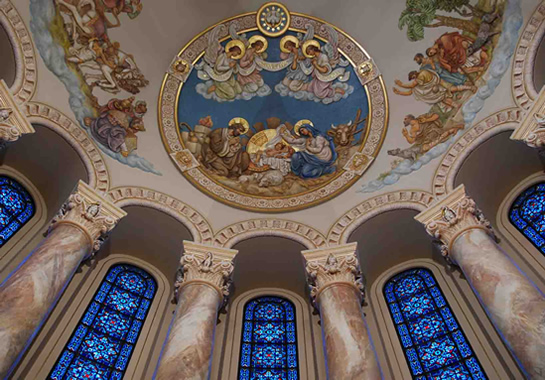Update, Feb. 5, 2013: Hey, Hey! More Pictures are Coming In
Update, Jan. 28, See photos by clicking here.
1-23-13 update: The work, obviously has fallen behind schedule and was not completed as the Sisters had hoped, by autumn. The date for the dedication of the newly renovated chapel has been set for Feb. 3.
The following was sent in to our comment box, but it deserves a post of its own. Thank you so much, Michael N. !
He wrote: “Here’s the story about Duncan Stroik’s project at the Carmelite Monastery in Traverse City.”
TRAVERSE CITY, MI – Duncan G. Stroik is one of the foremost church architects in the English-speaking world, the acknowledged leader of a growing movement to return classical ideas of beauty and harmony to sacred architecture.
His recent commissions have included the 2008 Shrine of Our Lady of Guadalupe in La Crosse, WI, the 2009 Chapel of St. Thomas Aquinas College in Santa Paula, CA and the renovation of St. Joseph Cathedral in Sioux Falls, SD. A professor of architecture at the University of Notre Dame, he authored the book Reconquering Sacred Space and is editor of the professional journal Sacred Architecture.
But his latest project is a tiny chapel for a small community of cloistered Carmelite nuns who live, work and pray at the Monastery of the Infant Jesus of Prague, in the northern Michigan resort town of Traverse City. Although the chapel is also open to visitors for daily Masses and prayer — and has a loyal following among local residents — it is central to the life of the monastic community.
“The beautification of the monastery chapel is exactly the type of project that we love to do,” said Stroik. “The sisters have a great love of beauty, of the liturgy and of tradition, and want to do something worthy of Christ. I love that the project is in Traverse City because it gives me a great excuse to travel up there. The fascinating part of the project is the sisters’ desire that the sanctuary be designed to be beautiful and inspiring from the nave as well as from their cloister chapel.”
Stroik is very interested in working with a Carmelite community for the first time, particularly because the project involves the renovation of an existing sanctuary. He believes that sanctuary renovations may be one of the most important parts of the new renaissance in sacred architecture. Much of his recent work has been in renovating uninspired churches by incorporating traditional standards of dignity and beauty that had been jettisoned by modernist architects.
“What I see today is a greater appreciation for a timeless sense of architecture and art,” he said. “We have built a lot over the past four decades, and one of the best things and most economical things to do is to respond to the renewal of liturgical theology through renovation of our churches.”
The monastery, located on 60 acres of wooded land on Silver Lake Road, was built in the 1960s in the utilitarian style typical of the time. After years of prayer and thought, the nuns decided it was time to renovate the chapel sanctuary to create “an atmosphere of sacred beauty and transcendence,” reflecting their order’s tradition that every experience of beauty is an experience of God.
That sentiment dovetails perfectly with Duncan Stroik’s philosophy. As it happens, the architect was already familiar with the Traverse City area, and a priest who was visiting the monastery – Fr. Peter Stravinskas — put the sisters in touch with him.
“When I asked Fr. Peter if he knew any good church design consultants, he said, ‘I know just the man. Duncan Stroik. He’s fixed a lot of messes,’” recalled Mother Mary. “Next thing we knew, we received word from Mr. Stroik that he would be honored to do it, and so he became our architect. Only after his portfolio arrived and we recognized the St. Thomas chapel did we realize who he was!”
Not that their current chapel is ugly, the nuns are quick to assert.
“It has some very beautiful elements, but we thought it would be difficult if not impossible to give it a more traditional and transcendent look due to its structure and small size,” said Sister Perpetua Marie, the sub-prioress of the community. “When we saw pictures of some of Mr. Stroik’s renovations, suddenly new horizons opened up to us, and I became very excited.”
Stroik’s plan for the chapel begins by elevating the sanctuary altar, installing a new altar railing, marble flooring, classical architectural ornamentation that conceals the dated structural elements, new shrines to the Infant Jesus of Prague and several Carmelite saints and improved iconography with Biblical inscriptions. There will be a tabernacle prominently placed on a rear altar, reminiscent of the high altars found in European monastic churches. Visually, the sanctuary will present a unified whole, with the Eucharistic Jesus at the center, surrounded by His saints.
The architect’s initial design called for more marble, but the nuns requested wood for the columns and altar rail to give the sanctuary a Spanish aesthetic – and to aid Michigan’s economy by using local labor and materials. Even the marble dealer chosen for the project lives in Detroit.
Stroik believes that “a talented architect can find a way to create a work of art within a limited budget, mainly through an efficient though elegant design, the judicious use of fine materials, and the appropriate use of architectural detail.” The nuns have been saving toward this project for years, but are also soliciting donations from friends and supporters to bring it to completion.
“Obedience to, and love for the Church is at the core of who we are as Carmelites,” said Mother Mary. “We want to gladly receive from the Church a living tradition and then to hand it on to others by example.”
Bishop Bernard Hebda of the Diocese of Gaylord, who often visits the monastery when he’s in Traverse City – and who made it one of his first stops when he was first made bishop in 2010 — is an enthusiastic supporter of the project.
“My deepest hope is that these sisters may soon offer their praise and prayers in a setting that reflects the best of Catholic theology and the deep reverence and beauty of their personal faith,” he wrote. “At a moment when Pope Benedict has invited the Church in the English-speaking world to renew its appreciation for the Mass, and as we actively embrace a new Roman Missal which restores some of the richness of our traditions, the timing is perfect for construction of a new sanctuary within the Carmelite monastery chapel.”
The sisters at the monastery are returning the favor, donating a life-size crucifix that has hung in their sanctuary for the past 50 years to St. Mary’s Cathedral in Gaylord. The cross was made from a single redwood tree, and the image of Christ upon it was crafted in northern Italy. It is an enlarged reproduction of a treasured crucifix that the nuns keep inside their cloister and is venerated by each new sister on the day she enters the monastery and bids farewell to the world.
The project is scheduled to get under way this spring, and the nuns are hoping it will be finished by fall. The Carmelite Order, which stresses simplicity, contemplation and prayer, was founded in the 11th century on the slopes of Mt. Carmel, in what is now Israel, and spread rapidly through Europe during the Middle Ages. In the 16th century it was reformed by two of the Catholic Church’s most noted mystical writers, St. Teresa of Avila and St. John of the Cross. Today there are thousands of Carmelite sisters and brothers in 960 monasteries around the world, including three other Michigan communities in Iron Mountain, near Detroit and outside Grand Rapids.
The Traverse City monastery traces its origins to a Mexican nun’s desperate prayer when she faced a firing squad during a wave of anti-Catholic persecution in 1914. Mother Mary Elias miraculously escaped death, and went on to bring her community safely to Grand Rapids. Mother Teresa Margaret, who founded the Traverse City monastery in 1950, is the only nun still alive today who made her novitiate under Mother Elias’ direction. She celebrated her 100th birthday at the monastery in September 2011.
As members of a cloistered, contemplative order, Carmelite sisters spend their days in private and liturgical prayer, spiritual reading, and domestic tasks such as baking Communions wafers. They don’t leave the monastery except for rare occasions such as doctor appointments. Even during Masses they remain within an enclosed choir area, separated from the public area of the chapel by a metal grille – which means they will only be able to see a part of the renovation work that Stroik is performing on their behalf.
Nevertheless, Mother Mary expects it to have a positive impact on their devotional lives.
“With the renovation we will all be able to see the crucifix, a traditional tabernacle, and a new Latin inscription from Hosea: I will lead her into the desert and speak to her heart,” she said. “If we can afford it, there will also be a painting of Our Lady of Mt. Carmel with the Saints of the Carmelite Order on the back wall. We will still be in our concrete block “box” but now it will have a window into Heaven—and isn’t that what every church building should be?”
The Monastery of the Infant Jesus of Prague is located at 3501 Silver Lake Road in Traverse City. […] Mass is celebrated at 7:30am on Sunday, Saturday and Holy days, and at 6:55am Monday through Friday. For more information about the renovation project, contact chapelrenovation@charter.net





Pingback: » More info on the Traverse City Carmelite Monastery Renovations Good Saints (Boni Sancti): Northern Michigan Catholic Dad Blog